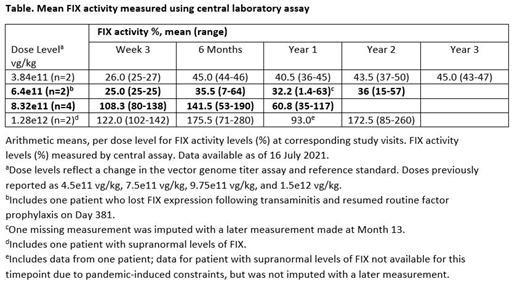Abstract

Introduction: FLT180a (verbrinacogene setparvovec) is an investigational, liver-directed AAV gene therapy for the treatment of patients with hemophilia B (HB). FLT180a consists of a novel, potent, engineered capsid (AAVS3) containing an expression cassette encoding a Factor IX (FIX) gain-of-function protein variant ('Padua'; FIX-R338L). The B-AMAZE study was designed to identify a dose of FLT180a that maintains FIX activity within the normal range (50-150%) and thereby protect patients with severe HB from spontaneous and traumatic bleeds.
Methods: B-AMAZE was a multicentre, open-label Phase 1/2 clinical trial (NCT03369444; sponsored by UCL) that evaluated FLT180a dose levels using an escalating/descending adaptive design in patients with severe (FIX activity <1%) or moderately severe (FIX activity 1-2%) HB who were negative for AAVS3 neutralizing antibodies. A novel regimen of prophylactic corticosteroids with/without tacrolimus was implemented to mitigate the impact of vector-related transaminitis on FIX expression. Patients who completed the 26-week B-AMAZE study were eligible for the ongoing long-term follow-up study (NCT03641703; sponsored by Freeline).
Results: Ten HB patients received a single dose of FLT180a. Four FLT180a doses ranging from 3.84e11 vg/kg to 1.28e12 vg/kg were assessed. As of the data cut-off date, all patients have been followed for ≥16 months.
FLT180a demonstrated a favorable safety profile, without evidence of inhibitors against FIX, infusion-related or allergic reactions. The most common treatment-related adverse event was transient elevation in alanine aminotransferase. An event of AV fistula thrombosis occurred in a 67-year-old patient who received the highest dose of 1.28e12 vg/kg (total dose of 1.15e14 vg) and had supranormal FIX levels; this patient was treated with anticoagulants. While these FIX levels demonstrate the potency of our proprietary AAVS3 capsid, this dose will not be used in future hemophilia studies.
At Week 26 after FLT180a administration, a dose-response relationship was observed with mean FIX activity of 45.0%, 35.5%, 141.5%, and 175.5% for 3.84e11, 6.4e11, 8.32e11, and 1.28e12 vg/kg doses, respectively (Table); FIX activity levels ≥50% were achieved in 7 of 8 patients treated with the three highest doses. One patient (Patient 4) who received 6.4e11 vg/kg lost transgene expression early due to transaminitis and resumed routine factor prophylaxis. The 8.32e11 vg/kg cohort received an extended immune management regimen (9-18 weeks) with prophylactic tacrolimus in addition to prednisolone to prevent breakthrough vector-related transaminitis. However, after cessation of the immune management regimen, transaminitis with concomitant reductions in FIX activity was observed in all patients in the 8.32e11 vg/kg cohort. The combination of prophylactic tacrolimus and prednisolone appeared to have suppressed immune-mediated transaminitis while administered, but recurrence of transaminitis developed soon after cessation. This unique and previously unreported observation suggests that the longer-duration prophylactic immune management regimen may have prevented tolerization to the vector because this was not observed in earlier cohorts where a brief course of tacrolimus was given reactively for breakthrough transaminitis. All patients (including the 8.32e11 vg/kg cohort) have achieved steady state. Patients in the earliest cohort who received the lowest dose (3.84e11 vg/kg) have shown stable FIX activity for >3 years.
There were no spontaneous bleeds that required FIX supplementation in patients who maintained FIX activity above 50%; Patient 4 in the 6.4e11 vg/kg cohort experienced two bleeds (cause unknown) after he lost transgene expression, which were treated with exogenous FIX. One patient received exogenous FIX for treatment of a traumatic bleed, but his FIX activity level was 57% at the time of the event. Additional efficacy and safety results with >3.5 years of follow-up will be presented.
Conclusions: B-AMAZE is the first HB gene therapy study to achieve normal levels of FIX activity using relatively low vector doses. Results suggest that a dose of 7.7e11 vg/kg, coupled with a short course of prophylactic immune management, has the potential to achieve durable FIX activity in the normal range (50-150%) and thereby prevent spontaneous bleeds and normalize hemostasis in the event of traumatic bleeds.
Chowdary: Sanofi: Honoraria; Roche: Honoraria; CSL Behring: Honoraria, Research Funding; Freeline: Honoraria, Research Funding; Novo Nordisk: Honoraria, Research Funding; Pfizer: Honoraria, Research Funding; SOBI: Honoraria, Research Funding; Takeda: Honoraria, Research Funding; Boehringer Ingelheim: Honoraria; Chugai: Honoraria; Spark: Honoraria; Bayer: Honoraria, Research Funding. Shapiro: Roche: Honoraria; CSL Bering: Honoraria; Takeda: Honoraria, Speakers Bureau; Pfizer: Consultancy, Speakers Bureau. Makris: Freeline: Consultancy. Dolan: Takeda: Speakers Bureau; Roche-Chugai: Speakers Bureau; Spark Therapeutics: Speakers Bureau; Octapharma: Speakers Bureau; CSL: Speakers Bureau; Biomarin: Speakers Bureau; Bayer: Research Funding, Speakers Bureau; Novo Nordisk: Research Funding, Speakers Bureau; Pfizer: Research Funding. Tuddenham: Freeline: Consultancy, Current holder of individual stocks in a privately-held company. Long: Freeline: Current Employment. Krop: Freeline: Current Employment. Nathwani: Freeline: Current holder of individual stocks in a privately-held company, Other: Board of directors.
Author notes
 This icon denotes a clinically relevant abstract
This icon denotes a clinically relevant abstract


This feature is available to Subscribers Only
Sign In or Create an Account Close Modal